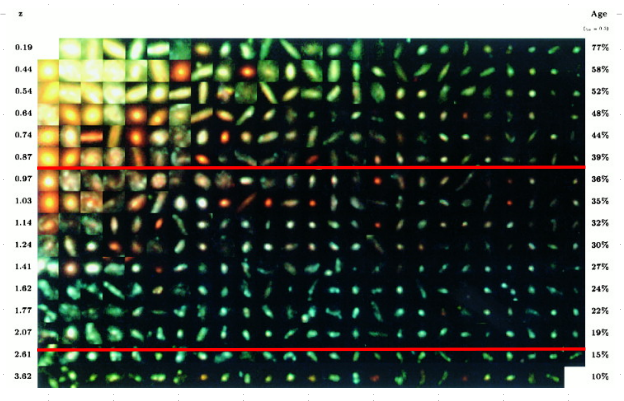MAGINASTE (MAssive Galaxies through INfrAred SpecTroscopy with EMIR)
PI: Marc Balcells
Background
Understanding the physical processes that lead galaxies to stop making stars at one point in their evolution is a major goal of the MAGINASTE Survey. The onset of the galaxy red sequence came hand in hand with the appearance of morphologically regular galaxies, and, roughly, coincides with the start of the decline of the SFR density of the Universe at 1<z<2, and increase of the typical stellar mass of the red galaxies.The MAGINASTE survey aims at studying in detail small samples of the most massive galaxies at z>2, the massive-‐starburst epoch, and z~1, the epoch when the most massive galaxies have just become passive.

Figure.- Hubble Deep Field photometric redshift sample. Within each redshift interval the galaxies are ordered in terms of apparent magnitude (and therefore crudely in absolute magnitude). The progression down the page qualitatively reflects the process of galaxy evolution, although of course it does not correct for k-corrections and the redshift-dependent selection windows (Driver et al 1998). Red lines delimites the interval time where MAGINASTE is going to observe massive red galaxies.
Objetives
Overarching goal is to explore the formation of the massive end of the galaxy mass function, and exploring two redshift ranges (a) near the peak of star formation for those objects accessible to EMIR (z 2.0 to 2.5) and (b) the redshift range where star formation is just finished for those massive galaxies (z 0.9-1.0). To obtain IMF diagnostics in these two periods. Most noteworthy of the above is the goal of searching for evidence that IMF is different (top-heavy) in z~2 strong starbursts, and hence to check a IMF prediction from galaxies in the local Universe. A second, related theme, is the improvement of the existing constraints on star formation history at the massive end of the mass function, by studying z~1 massive galaxies.
In MAGINASTE z~1 the goal is to characteriz the stellar populations and dynamics of massive galaxies we believe to be passive, using the same observational diagnostics we use in the local Universe. This is the old leit - motif for NIR MOS spectroscopy: being able to compare distant galaxies to local ones with the same set of observables. But we add a twist: we focus on features that provide IMF information. Velocity dispersions will be measured for dynamical masses, ratio of dynamical to stellar masses, fundamental plane, mass plane and so forth.
In MAGINASTE z>2 the goal is to obtain diagnostics on star formation in galaxies undergoing some of the most violent starbursts in the Universe, so as to characterize the differences between star formation processes in violent phase vs more normal star formation
Procedures
Our samples will be selected in baryonic mass, or rest-frame K-band luminosity, on fields with HST imaging. Color-color criteria will be used to preselect galaxies in the range 1<z<2. EMIR will provide Hα emission as well as absorption line spectroscopy of the brightest targets; we will cover the rest-frame 5000 Å region that includes Hβ, Mg, and several Fe lines, which project onto the middle of the J band at z=1.5. With a spectral resolution of R=4000, we will be able to map the absorption lines through the forest of OH telluric lines. Mg and Fe indices will provide information on the ages and metallicities of the stellar populations. On fainter targets, the 4000 Å break will provide an additional age indicator. The multiplex capability of EMIR makes long integrations practical. These will provide a representative sample of galaxies with measurements of absorption line indices and velocity dispersions.